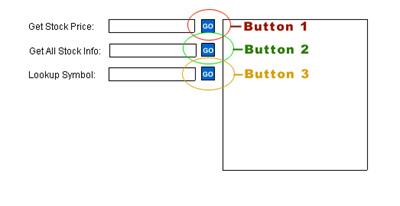Cross-Language Remoting with mod_perlservice
Mod_perlservice? What is That?
Mod_perlservice is a cool, new way to do remoting – sharing data between server and client processes – with Perl and Apache. Let’s start by breaking that crazy name apart: mod + perl + service.
Mod means that it’s a module for the popular and ubiquitous Apache HTTP Server. Perl represents the popular and ubiquitous programming language. Service is the unique part. It’s the new ingredient that unifies Apache, Perl, and XML into an easy-to-use web services system.
With mod_perlservice, you can write Perl subs and packages on your server and call them over the internet from client code. Clients can pass scalars, arrays, and hashes to the server-side subroutines and obtain the return value (scalar, array, or hash) back from the remote code. Some folks refer to this functionality as “remoting” or “RPC,” so if you like you can say mod_perlservice is remoting with Perl and Apache. You can write client programs in a variety of languages; libraries for C, Perl, and Flash Action Script are all ready to go.
Now that you know what mod_perlservice is, let’s look at why it is. I believe that mod_perlservice has a very clean, easy-to-use interface when compared with other RPC systems. Also, because it builds on the Apache platform it benefits from Apache’s ubiquity, security, and status as a standard. Mod_perlservice sports an embedded Perl interpreter to offer high performance for demanding applications.

How Can I Use mod_perlservice?
Mod_perlservice helps create networked applications that require client-server communication, information processing, and sharing. Mod_perlservice is for applications, not for creating dynamic content for your HTML pages. However, you surely can use it for Flash remoting with Perl. Here are some usage examples:
- A desktop application (written using your favorite C++ GUI library) that records the current local air temperature and sends it to an online database every 10 minutes. Any client can query the server to obtain the current and historical local air temperature of any other participating client.
- A Flash-based stock portfolio management system. You can create model stock portfolios and retrieve real-time stock quote information and news.
- A command-line utility in Perl that accepts English sentences on standard input and outputs the sentences in French. Translation occurs in server-side Perl code. If the sentence is idiomatic and the translation is incorrect, the user has the option of sending the server a correct translation to store in an online idiom database.
How Do I Start?
Let’s move on to the fun stuff and set up a working installation. Before we begin, make sure you have everything you need! You need Apache HTTPD, Perl, Expat, mod_perlservice, and a mod_perlservice client library (Perl Client | C Client | Flash Client). You must download a client library separately, as the distribution does not include any clients! In your build directory:
myhost$ tar -xvzf mod_perlservice.tar.gz
myhost$ cd mod_perlservice
myhost$ ./configure
myhost$ make
myhost$ make install
If everything goes to plan, you’ll end up with a fresh mod_perlservice.so in your Apache modules directory, (usually /etc/apache/modules). Now it’s time to configure Apache to use mod_perlservice. cd into your Apache configuration directory (usually /etc/apache/conf) Add the following lines to the file apache.conf (or httpd.conf, if you have only a single configuration file):
LoadModule perlservice_module modules/mod_perlservice.so
AddModule mod_perlservice.c
Add the following lines to commonapache.conf, if you have it and httpd.conf if you don’t:
<IfModule mod_perlservice.c>
<Location /perlservice> SetHandler
mod_perlservice
Allow From All PerlApp
myappname /my/app/dir
#Examples
PerlApp stockmarket /home/services/stockmarket
PerlApp temperature /home/services/temperature
</Location>
</IfModule>
Pay close attention to the PerlApp directive. For every mod_perlservice application you want to run, you need a PerlApp directive. If I were creating a stock market application, I might create a directory: /home/services/stockmarket and add the following PerlApp directive:
PerlApp stockmarket /home/services/stockmarket
This tells mod_perlservice to host an application called stockmarket with the Perl code files located in the /home/services/stockmarket directory. You may run as many service applications as you wish and you may organize them however you wish.
With the configuration files updated, the next step is to restart Apache:
myhost$ /etc/init.d/apache restart
or
myhost$ apachectl restart
Now if everything went as planned, mod_perlservice should be installed. Congratulations!
An Example
Let’s create that stock portfolio example mentioned earlier. It won’t support real-time quotes, but will instead create a static database of common stock names and historical prices. The application will support stock information for General Electric (GE), Red Hat (RHAT), Coca-Cola (KO), and Caterpillar (CAT).
The application will be stockmarket and will keep all of the Perl files in the stock market application directory (/home/services/stockmarket). The first file will be quotes.pm, reading as follows:
our $lookups = {
"General Electric" => "GE",
"Red Hat" => "RHAT",
"Coca Cola" => "KO",
"Caterpillar Inc" => "CAT"
};
our $stocksymbols = {
"GE" => {
"Price" => 33.91,
"EarningsPerShare" => 1.544
},
"RHAT" => {
"Price" => 14.96,
"EarningsPerShare" => 0.129
},
"KO" => {
"Price" => 42.84,
"EarningsPerShare" => 1.984
},
"CAT" => {
"Price" => 75.74,
"EarningsPerShare" => 4.306
}
};
package quotes;
sub lookupSymbol {
my $companyname = shift;
return $lookups->{$company_name};
}
sub getLookupTable {
return $lookups;
}
sub getStockPrice {
my $stocksymbol = shift;
return $stocksymbols->{$stocksymbol}->{"Price"};
}
sub getAllStockInfo {
my $stocksymbol = shift;
return $stocksymbols{$stocksymbol};
}
1;
That’s the example of the server-side program. Basically, two static “databases” ($lookups and $stocksymbols) provide information about a limited universe of stocks. The above methods query the static databases; the behavior should be fairly self-explanatory.
You may have as many .pm files in your application as you wish and you may also define as many packages within a .pm file as you wish. An extension to this application might be a file called news.pm that enables you to fetch current and historical news about your favorite stocks.
Now let’s talk some security. As it stands, this code won’t work; mod_perlservice will restrict access to any file and method you don’t explicitly export for public use. Use the .serviceaccess file to export things. Create this file in each application directory you declare with mod_perlservice or you’ll have no access. An example file might read:
<ServiceAccess>
<AllowFile name="quotes.pm">
Allow quotes::*
</AllowFile>
</ServiceAccess>
In the stock market example, this file should be /home/services/stockmarket/.serviceaccess. Be sure that the apache user does not own this file; that could be bad for security. This file allows access to the file quotes.pm and allows public access to all (*) the methods in package quotes.
If I want to restrict access only to getStockPrice, I would have written Allow quotes::getStockPrice. After that, I could add access to lookupSymbol with Allow quotes::lookupSymbol. To make quotes.pm public carte blanche, use Allow *. You won’t need to restart Apache when you make changes to this file as it reloads automatically.
Client Code
Well, so far I’ve only shown you half the story. It’s time to create some client-side code. This client example uses the Flash “PerlService” library, just one of the client-side interfaces to mod_perlservice. The Flash client works well for browser interfaces while the Perl and C clients can create command-line or GUI (ie, GTK or Qt) applications. This article is on the web, so we’ll give the Flash interface a spin and then go through an example in Perl.
The first code smidgen should go in the first root frame of your Flash application. It instantiates the global PerlService object and creates event handlers for when remote method calls return from the server. The event handlers output the requested stock information to the display box.
#include "PerlService-0.0.2.as"
// Create a global PerlService object
// Tell the PerlService object about the remote code we want to use:
// arg1) host: www.ivorycity.com
// arg2) application: stockmarket
// arg3) file: quotes.pm
// arg4) package: quotes
_global.ps = new PerlService("www.ivorycity.com","stockmarket","quotes.pm","quotes");
// First declare three callback functions to handle return values
function onStockPrice(val) {
output.text = "StockPrice: " + symbolInput.text + " " + val + "\n" + output.text;
}
function onAllStockInfo(val) {
output.text = "Stock Info: " + allInfoInput.text + "\n" + "\tPrice: "
+ val.Price + "\n" + "\tEarnings Per Share: "
+ val.EarningsPerShare + "\n" + output.text;
}
function onLookupSymbol(val) {
output.text = "Lookup Result: " + symbolInput.text + " " + val + "\n"
+ output.text;
}
// Register callback handlers for managing return values from remote methods
// ie, onStockPrice receives the return value from remote method getStockPrice
ps.registerReplyHandler( "getStockPrice", onStockPrice );
ps.registerReplyHandler( "getAllStockInfo", onAllStockInfo );
ps.registerReplyHandler( "lookupSymbol", onLookupSymbol );
Now for the code that makes things happen. The following code attaches to three separate buttons. When clicked, the buttons call the remote Perl methods using the global PerlService object. Flash Action Script is an event-driven system, so click event-handlers will call the remote code and return event-handlers will do something with those values.
 Figure 1. Button and code associations.
Figure 1. Button and code associations.
When a user presses Button 1, call the remote method getStockPrice and pass the text in the first input box as an argument.
on (release) {
ps.getStockPrice(box1.text);
}
When the user presses Button 2, call the remote method getAllStockInfo and pass the text in the second input box as an argument.
on (release) {
ps.getAllStockInfo(box2.text);
}
When the user presses Button 3, call the remote method lookupSymbol and pass the text in the third input box as an argument.
on (release) {
ps.lookupSymbol(box3.text);
}
That’s the entire Flash example. Here is the finished product.
Perl Client
Not everyone uses Flash, especially in the Free Software community. The great thing about mod_perlservice is that everyone can join the party. Here’s a Perl Client that uses the same server-side stock market API.
use PService;
my $hostname = "www.ivorycity.com";
my $appname = "stockmarket";
my $filename = "quotes.pm";
my $package = "quotes";
#Create the client object with following arguments:
#1) The host you want to use
#2) The application on the host
#3) The perl module file name
#4) The package you want to use
my $ps = PSClient->new( $hostname, $appname, $filename, $package );
# Just call those remote methods and get the return value
my $price = $ps->getStockPrice("GE");
my $info = $ps->getAllStockInfo("RHAT");
my $lookup = $ps->lookupSymbol("Coca Cola");
#Share your exciting new information with standard output
print "GE Price: " . $price . "\n";
print "Red Hat Price: " . $info->{Price} . "\n";
print "Red Hat EPS: " . $info->{EarningsPerShare} . "\n";
print "Coca-Cola's ticker symbol is " . $lookup . "\n";
Using the PSClient object to call remote methods might feel a little awkward if you expect to call them via quotes::getStockPrice(), but think of the $ps instance as a proxy class to your remote methods, if you like.
If things don’t work, use print $ps->get_errmsg(); to print an error message. $ps->get_errmsg(); That’s a local reserved function, so it doesn’t call the server. It’s one of a few reserved functions detailed in the Perl client reference.
As you can see, it requires much less work to create an example with the Perl client. You simply instantiate the PSClient object, call the remote methods, and do something with the return values. That’s it. There is no protocol decoding, dealing with HTTP, CGI arguments, or any of the old annoyances. Your remote code may as well be local code.
Thanks for Taking the Tour
That’s mod_perlservice. I’m sure many of you who are developing client-server applications can see the advantages of this system. Personally, I’ve always found the existing technologies to be inflexible and/or too cumbersome. The mod_perlservice system offers a clean, simple, and scalable interface that unites client-side and server-side code in the most sensible way yet.
What’s next? mod_parrotservice!
Tags
Feedback
Something wrong with this article? Help us out by opening an issue or pull request on GitHub





